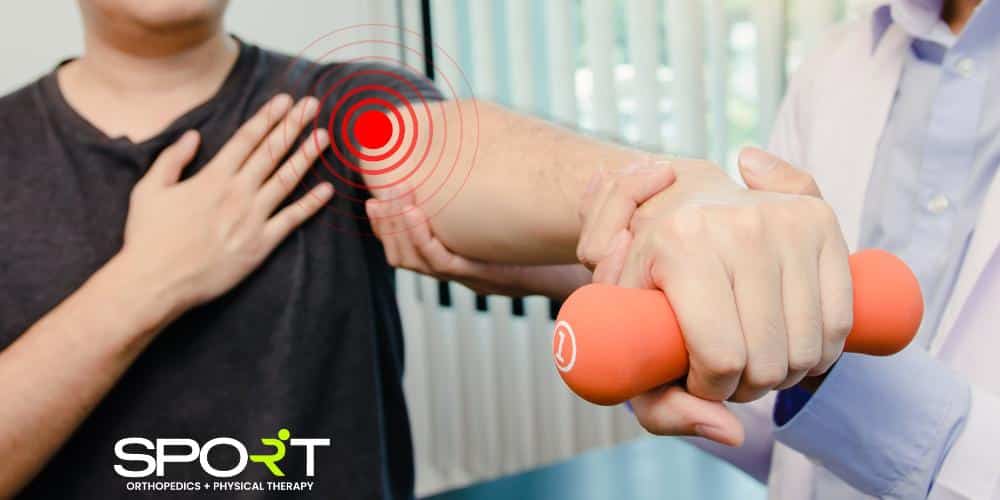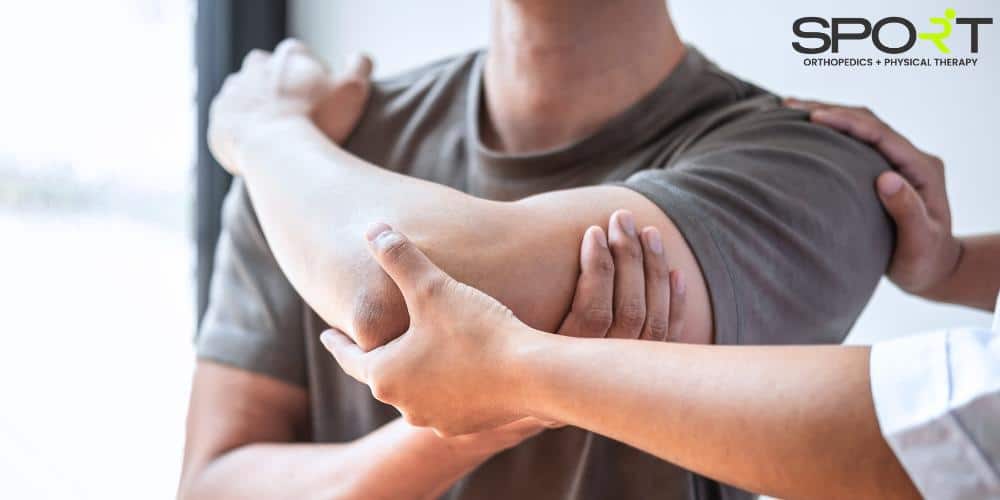Upper Arm Pain Treatment in Dallas, Frisco, Prosper, and Wylie, TX
Upper Arm Muscle Pain, Pain in Upper Arm, Pain in Both Upper Arms
Home » Conditions » Upper Arm Pain Treatment in Dallas, Frisco, Prosper, and Wylie, TX
Why Does My Upper Arm Hurt?
Having upper arm pain can seriously limit one’s ability to perform athletic activities, let alone general, everyday activities. Whether it’s intermittent pain or constantly occurring, sharp pains or dull and achy, irritating or debilitating, or in one particular area versus in the whole arm, there are loads of ways in which someone might experience upper arm pain. Additionally, there are various reasons why upper arm muscle pain might develop in the first place.
As you know, there are several important working parts within your arm. These include bones, muscles, joints, ligaments, nerves, tendons, and blood vessels, all of which are subject to injury, disease, infection, and a number of potential conditions. One upper arm pain condition in particular is what is known as bicep tendonitis.
Treating bicep tendonitis requires an in-depth understanding of the tendons, muscles, and ligaments of your arm, as well as an inherent skill in medicine and physical therapy. At SPORT, we pride ourselves on possessing the necessary knowledge and specialized skill to eliminate pain and help you get back to your active lifestyle.
Our Texas sports medicine doctors serve patients in the Dallas and Frisco area, treating all types of conditions such as bicep tendonitis, shin splints, runner’s knee, trigger finger, and much more. For a personalized treatment plan targeting your upper arm muscle pain, call 469-200-2832 to schedule an appointment with our qualified physicians.
Types of Upper Arm Pain
Upper arm pain may stem from various causes, ranging from simple overuse to more complex systemic conditions. It’s important to understand the nuances of pain in different parts of the upper arm, as these can hint at the underlying causes.
Pain in Upper Right Arm Between Elbow and Shoulder
There are a few potential reasons why someone might experience pain in the upper right arm between their elbow and shoulder. Upper arm muscle pain doesn’t necessarily have to have an underlying disease or condition that’s causing it. It is possible that your arm is simply sore due to strength training or general exercise.
There is also a possibility that you have a sprain or strain in the ligaments of your arm or even tendonitis in the elbow, also known as tennis elbow. Some people actually get tennis elbow from lifting weights.
However, if you’re experiencing pain in upper right arm (or left arm, for that matter) between the elbow and shoulder, there is a strong possibility that you have what is referred to as bicep tendonitis.
Pain in Upper Left Arm Between Elbow and Shoulder
When it comes to pain in the upper left arm between the elbow and shoulder, it’s often related to overuse injuries or strain to the muscles and tendons. Repetitive motions, such as those in sports or certain occupations, can lead to conditions like tendinitis or bursitis. Arm and shoulder pain can have similar causes, so it’s important to seek evaluation by an orthopedic specialist for a swift diagnosis.
Stabbing Pain in Upper Right Arm
Stabbing pain in the upper right arm can be particularly alarming due to its intensity and sudden onset. This type of pain might be caused by nerve compression or neuropathy, where the nerve pathways are irritated or damaged. Conditions such as a cervical herniated disc or thoracic outlet syndrome are potential culprits for this kind of sharp, severe pain.
Left Arm Pain from Shoulder to Hand
Left arm pain from shoulder to hand can encompass a wide range of issues, including nerve compression, circulatory problems, or musculoskeletal conditions. Given its extensive reach, this pain can be linked to carpal tunnel syndrome, where the median nerve is compressed at the wrist, or even to angina or heart attack, especially if it’s acute and accompanied by other symptoms like nausea or sweating.
Pain in Both Upper Arms at Night
Pain in both upper arms at night might be due to a variety of factors, including poor posture during sleep, nerve compression, or conditions like fibromyalgia, where widespread musculoskeletal pain is a hallmark. Nighttime pain can significantly impact sleep quality and may be exacerbated by the lack of distraction from daytime activities. Some people only experience mild discomfort at night, while others have a hard time sleeping because of the pain.
Pain in Both Upper Arms and Shoulders
Pain in both upper arms and shoulders can indicate systemic conditions such as rheumatoid arthritis or polymyalgia rheumatica, especially if the pain is symmetrical and accompanied by stiffness, particularly in the morning. These conditions cause inflammation in the joints and muscles, leading to pain and discomfort in multiple areas, including the upper arms and shoulder joint areas.
Upper Arm Muscle Pain
Upper arm muscle pain, irrespective of the side, is commonly attributed to muscle overuse, strain, or sudden injury. This type of pain can also be caused by muscle tension from stress or poor ergonomic setups at work or home. Muscle pain is often described as aching or soreness and can be alleviated with rest, physical therapy, or proper ergonomics.

My Upper Arm Hurts When I Raise It – Why?
As we’ve said, there are many different causes and conditions that may cause upper arm pain when lifting the arm. If it is found to be bicep tendonitis that is causing this pain, there are a few things that may have contributed to its development in the first place.
Aging or general use over time can cause wear and tear of the tendon, which may lead to bicep tendonitis. Someone who overuses this tendon (especially in repetitive overhead motions) is more likely to develop this condition. This may come from playing sports, exercising, or even everyday work activities.
A fall or other accident resulting in an injury to the tendon may lead to the development of bicep tendonitis. Someone who has had previous problems in the shoulder area, such as a rotator cuff tear or shoulder impingement, may also be more likely to experience this condition.
What Causes Upper Arm Pain?
Upper arm pain primarily stems from orthopedic conditions such as muscle strains, tendonitis, bursitis, or injuries to the shoulder joint, including rotator cuff tears or shoulder impingement syndrome. These conditions often arise due to repetitive strain, overuse, aging, or direct injuries to the arm or shoulder.
While the pain is usually localized, reflecting the affected muscles, tendons, or joints, it can also radiate along the arm. Although less common, it’s important to acknowledge that upper arm pain, particularly on the left side, can sometimes be a sign of a heart attack. This is especially true if accompanied by other symptoms like chest pain, shortness of breath, or nausea. If you suspect you have heart attack arm pain, it’s important to contact a doctor immediately.
Other orthopedic causes of upper arm pain include the following.

Pinched Nerve
A common cause of upper arm pain is a pinched nerve, often originating in the neck or shoulder region. This occurs when surrounding tissues such as bones, cartilage, muscles, or tendons exert excessive pressure on a nerve, leading to pain, numbness, or weakness that can radiate down the arm to the fingers. Conditions such as cervical radiculopathy can manifest as a pinched nerve in the neck, causing pain to radiate down into the upper arm.
Sprains and Strains
Sprains and strains also contribute significantly to upper arm pain. While a sprain refers to ligament damage caused by overstretching or tearing, a strain involves muscles or tendons. These injuries typically result from sudden movements or overuse during physical activities, leading to arm pain, shoulder pain, swelling, and reduced mobility in the affected area.
Fractures
Fractures of the upper arm bone (humerus) or nearby bones can cause extreme pain, swelling, and an inability to move the arm. A broken arm is usually the result of direct trauma or falls, necessitating immediate medical attention for proper healing and function restoration.
Joint Inflammation
Joint inflammation, including arthritis in the shoulder joint, can lead to chronic upper arm pain. This inflammation can be due to autoimmune diseases like rheumatoid arthritis or age-related wear and tear, as seen in osteoarthritis. The pain is often described as a persistent ache that worsens with movement or during the night.
Dislocations
Shoulder dislocations where the head of the humerus is displaced from the shoulder socket, can cause intense pain and immobility in the upper arm. These traumatic injuries require prompt medical intervention to realign the joint and prevent further damage.
Shoulder Impingement Syndrome
Shoulder impingement syndrome occurs when the bony structures of the shoulder blade compress the rotator cuff tendons and the subacromial bursa, leading to pain during arm lifting. This condition is common in individuals who engage in activities involving overhead motions.
Frozen Shoulder
Frozen shoulder, or adhesive capsulitis, involves stiffness and pain in the shoulder joint due to the tightening and thickening of the joint capsule. This shoulder injury develops gradually and goes through stages from painful freezing to eventual thawing, significantly affecting arm movement.
Tendonitis Upper Arm
Tendonitis in the upper arm is often related to the inflammation of the biceps tendon, causing pain at the front of the shoulder and down the upper arm. This condition is typically due to repetitive motion or overuse, making it common among athletes and manual laborers. Tendonitis is one of the most common overuse injuries.
Rotator Cuff Injuries
Rotator cuff injuries, which may range from mild strains to complete tears, are a prevalent cause of upper arm pain. The rotator cuff is a group of muscles and tendons stabilizing the shoulder. A rotator cuff injury can result from acute trauma or gradual wear and tear, leading to pain, especially when lifting the arm or at night.
Upper Arm Pain Treatments
To relieve arm pain, it’s important first to diagnose the source of the pain. Treatment options heavily depend on the condition or injury causing the pain. Generally, we start with conservative methods before progressing to more invasive options if necessary.
Physical Therapy for Upper Arm Pain
Physical therapy is a cornerstone in the management of upper arm pain, regardless of the cause. It involves exercises tailored to strengthen the arm muscles, improve flexibility, and increase range of motion, thereby helping to relieve pain and preventing future injuries.

Physical therapists may also employ techniques such as massage, heat and cold therapy, and ultrasound to alleviate pain and inflammation. One example of a popular massage therapy treatment is the Graston technique. For conditions like frozen shoulder, shoulder impingement syndrome, or after surgery, physical therapy is crucial for recovery and regaining full function.
Upper Arm Muscle Pain Treatment
For upper arm muscle pain treatment, a combination of rest, ice, compression, and elevation (RICE) is often recommended initially to reduce inflammation and alleviate pain. Over-the-counter pain relievers and anti-inflammatory medications can also be used to manage symptoms. Muscle pain resulting from strains or minor injuries usually responds well to these conservative treatments.
Additionally, modifying activities to avoid movements that exacerbate the pain is advised until the muscle has healed. For persistent or severe muscle pain, a healthcare provider may recommend specific physical therapy exercises or possibly corticosteroid injections to reduce inflammation.
Surgery for Upper Arm Pain
Surgery may be considered for upper arm pain when conservative treatments have failed, or the underlying condition is severe, such as in cases of significant rotator cuff tears, severe shoulder impingement syndrome, or broken bones.
Surgical interventions can range from minimally invasive arthroscopic procedures to repair damaged tissues or remove bone spurs to more extensive surgeries like shoulder joint replacement. The type of surgery is tailored to the individual’s specific condition and needs.
Upper Arm Pain Specialist in Dallas, TX
Depending on the severity of your condition, our orthopedic specialists at SPORT will personalize a treatment plan just for you. From exercise recommendations to physical therapy to even surgery, we’re ready to help you, whatever it takes! To start your recovery journey, give us a call or fill out our online intake form.


